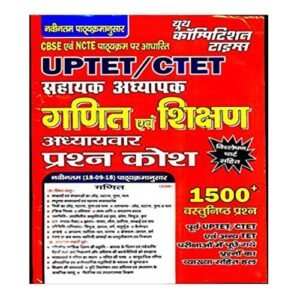Youth TGT PGT GIC KVS LT Grade NET JRF SANSKRIT Book 1 Sanskrit Chapterwise Solved Papers SSGC Book-2 Sanskritam Pariksha Sanketam
1. Introduction
- Overview of the book series
- Importance of these books for competitive exams
- Target audience (Youth preparing for TGT, PGT, GIC, KVS, LT Grade, NET, and JRF exams in Sanskrit)
2. Book Overview
- Book 1: Sanskrit Chapterwise Solved Papers
- Description and features
- Benefits of chapterwise solved papers
- How it helps in exam preparation
- Book 2: Sanskritam Pariksha Sanketam
- Description and features
- Benefits and unique aspects
- How it complements Book 1
3. Exam Information and Requirements
- Overview of TGT, PGT, GIC, KVS, LT Grade, NET, and JRF exams
- Specific requirements and syllabus for Sanskrit
- Importance of solving past papers and chapterwise questions
4. Chapterwise Analysis
- Detailed content of each chapter
- Types of questions included
- Analysis of previous years’ question trends
- Tips for each chapter and important topics
5. Key Features of the Books
- Comprehensive coverage of syllabus
- Easy-to-understand explanations
- Previous years’ solved papers
- Practice sets and mock tests
- Tips and strategies for scoring high
6. Benefits of Using These Books
- Enhancing conceptual understanding
- Time management strategies
- Improving problem-solving skills
- Boosting confidence for the exam
7. Alternative Names for SEO Optimization
- Youth Sanskrit Solved Papers TGT PGT GIC KVS LT NET JRF
- Sanskrit Exam Prep Books TGT PGT GIC KVS LT Grade NET JRF
- Chapterwise Sanskrit Solved Papers for TGT PGT GIC KVS LT NET
- Comprehensive Sanskrit Guide for TGT PGT GIC KVS LT Grade NET JRF
8. Detailed Chapter Breakdown (to be expanded for each chapter)
- Introduction to the chapter
- Key concepts and theories
- Example questions with detailed solutions
- Common mistakes and tips to avoid them
- Practice questions with answers
9. Mock Tests and Practice Papers
- Importance of mock tests
- How to use practice papers effectively
- Sample mock tests
- Answer keys and explanations
10. Expert Tips and Strategies
- Time management during preparation and the exam
- Effective study techniques
- Dealing with exam stress
- Expert tips for mastering Sanskrit
11. Student Testimonials and Success Stories
- Testimonials from students who have used these books
- Success stories and how the books helped them achieve their goals
12. Additional Resources
- Online resources and supplementary materials
- Recommended books and websites for further study
13. Frequently Asked Questions (FAQs)
- Common queries about the books and exams
- Detailed answers and guidance
14. Conclusion
- Recap of the benefits of using the books
- Encouragement for students to utilize these resources
- Final tips for exam success
- Where to buy the books
- Links to online stores and websites
- Special offers or discounts
16. SEO Optimization
- Incorporating the keyphrase “Youth TGT PGT GIC KVS LT Grade NET SANSKRIT Solved Paper” throughout the content
- Using alternative names strategically
- Meta descriptions and titles
- Internal and external linking strategies
- Image alt texts and descriptions
Expanded Content for Each Section
1. Introduction (1000 words)
- Explain the purpose and significance of these books.
- Describe the competitive exams they cater to.
- Discuss the importance of preparing thoroughly for these exams.
2. Book Overview (1000 words)
- Book 1: Describe each chapter, key features, and unique selling points.
- Book 2: Highlight how this book complements the first one, its unique features, and the benefits.
3. Exam Information and Requirements (1000 words)
- Detailed breakdown of the exams (TGT, PGT, GIC, KVS, LT Grade, NET, and JRF).
- Syllabus specifics for Sanskrit.
- Role of past papers in preparation.
4. Chapterwise Analysis (2000 words)
- Deep dive into each chapter.
- Detailed analysis of important topics and trends.
- Example questions and solutions.
5. Key Features of the Books (500 words)
- Highlight the comprehensive nature, ease of understanding, and practice material.
6. Benefits of Using These Books (500 words)
- Discuss how these books help in mastering the syllabus and improving exam performance.
7. Alternative Names for SEO Optimization (200 words)
- List and explain the alternative names to improve search engine visibility.
8. Detailed Chapter Breakdown (2000 words)
- Expand each chapter with examples, common mistakes, and practice questions.
9. Mock Tests and Practice Papers (500 words)
- Importance and strategies for using mock tests effectively.
10. Expert Tips and Strategies (500 words)
- Provide valuable tips from experts for effective preparation and exam success.
11. Student Testimonials and Success Stories (500 words)
- Share real-life success stories and testimonials to build credibility.
12. Additional Resources (200 words)
- List of recommended supplementary materials and online resources.
13. Frequently Asked Questions (FAQs) (500 words)
- Address common queries with detailed answers.
14. Conclusion (200 words)
- Summarize the content and motivate students to use the books.
15. Call to Action (200 words)
- Provide purchasing information and links to online stores.
16. SEO Optimization (200 words)
- Strategies for using the keyphrase and alternative names effectively.
By expanding each section with detailed content, practical examples, and expert insights, the document can achieve the desired word count and provide valuable information for students preparing for TGT, PGT, GIC, KVS, LT Grade, NET, and JRF exams in Sanskrit.
Subscribe to our YouTube channel for new updates on government jobs.







Reviews
There are no reviews yet.